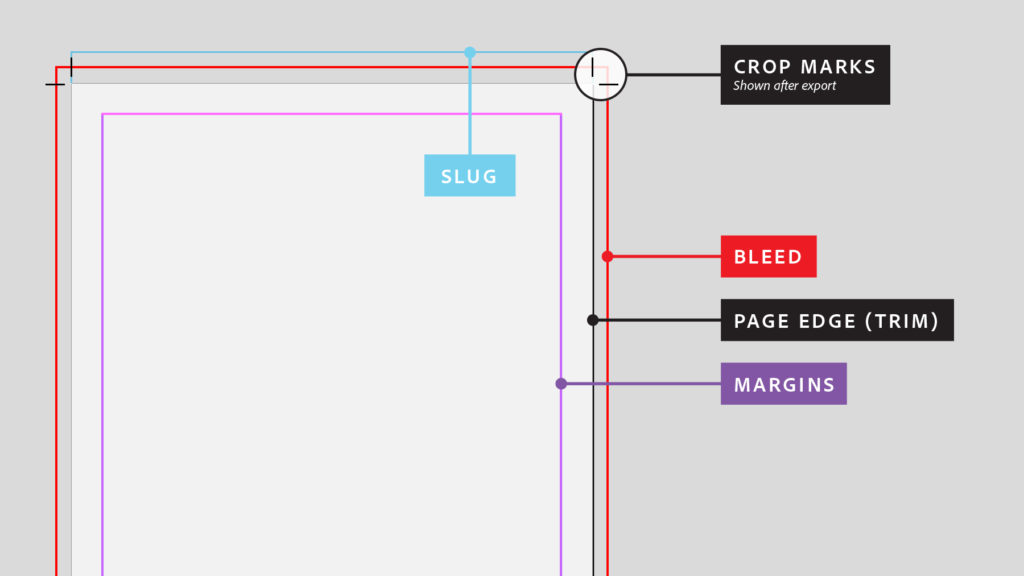It is impossible to discuss all aspects of image treatment in publications. Like most media today, the ideas and expectations are shifting regularly. That having been said, here are a few ideas:
All publications use photos, illustrations, infographics, and iconography. As of 2020 the standard resolution for printable imagery is 300 dpi (dots per inch) or ppi (pixels per inch). Most professionals create their images for publication at a minimum of twice the expected image resolution. So if the intended output is a fourth page ad in an 8.5″X11″ magazine, one would make the original file 8.5″X2.75″ at 600 dpi, then account for bleed, printable area and margins.

Remember, the margin may be different on either side to account for the spine of the publication and how malleable the inner gutter unfolds. If it is a large publication the inner margin may be as much as an inch, while the outer margin is only a half an inch. These are decisions the book designer needs to make in order to insure that the book comes out looking polished and legible.
Remember that when it comes to images, you can reduce them in scale, but you cannot make raster graphics larger without suffering quality problems. I have seen many disappointed designers who built things for websites, then wanted to convert those materials to books, and were extremely disappointed to discover that all their images had to be re-created to account for the demands of print publishing rather than web/digital publishing. The gap between these two worlds is shrinking, but the standard screen resolution is still 72 ppi, which is much lower than 300 dpi. Current retina screens are 144 ppi (72X2), but that is still less than half the stand resolution for print.
Kinds of Images Used in Different Publications
Again, this is impossible to foresee with the shifting media landscape, but generally newspapers need images that convey something immediate, while magazines can afford to use images that convey less immediate information. Newspapers and news websites are in the business of conveying information as it unfolds, in as simple and articulate a way as possible. Magazines are in the business of slowing down and focusing on a topic at length.
Photographs
Photographs can be acquired in a few different ways.
- You can take them yourself. Actually, there are a number of news organizations that are essentially training their reporters to collect photos and video for publication using smart phones. There is an “old guard” who hate this and decry it as the end of professional journalism, but it does not change the fact that newspapers and news websites are having a harder time making ends meet financially. If they want to continue staying competitive it makes sense that they would find a way to get the materials they need in as inexpensive a way as possible. However, I agree that switching to a smart phone instead of a camera with “good glass” is not going to give you the same quality. Some reporters are learning to shoot with DSLRs, and I hope that trend continues. If you are in this class, you have the training or are getting the training to use a camera. This gives you a small leg up compared with much of the competition.
- You can hire a photographer/commission a photographer. This is pretty easy. There are a ton of photographers looking for work. I’ve seen many “2 person teams” work at this sort of thing very successfully, where one does the “ideation” and writing for an article and the other collects the materials and completes the design. Here’s another idea: some editors will purposefully not tell a photographer the point of the story, maybe just the subject, then see what the photographer comes up with. Sometimes this can lead to an interesting juxtaposition of ideas. Also, remember that the photo you have commissioned can be edited through image manipulation software, like photoshop, if you need the image to convey something slightly different from what you received. Often the role of photo editing is a whole discipline unto itself. Sometimes photo editing is as simple as cropping so you are only publishing the part of the image one needs to see.
- You can purchase photos from a website like “gettyimages” or “shutterstocK”. They will supply high resolution versions of the image you want/need.
Illustration
At one point in time all images in publications were illustrations because the printers needed very specific parameters in order to reproduce images effectively. With current print technology illustrations are in far less demand, though most publishers still use illustration for icons and branding. Some publishers use illustration helps a publication by expressing an idea more abstractly, or figuratively. If a reader sees a photograph that is what it is. If they see an illustration they intuitively understand the illustration is an approximation.